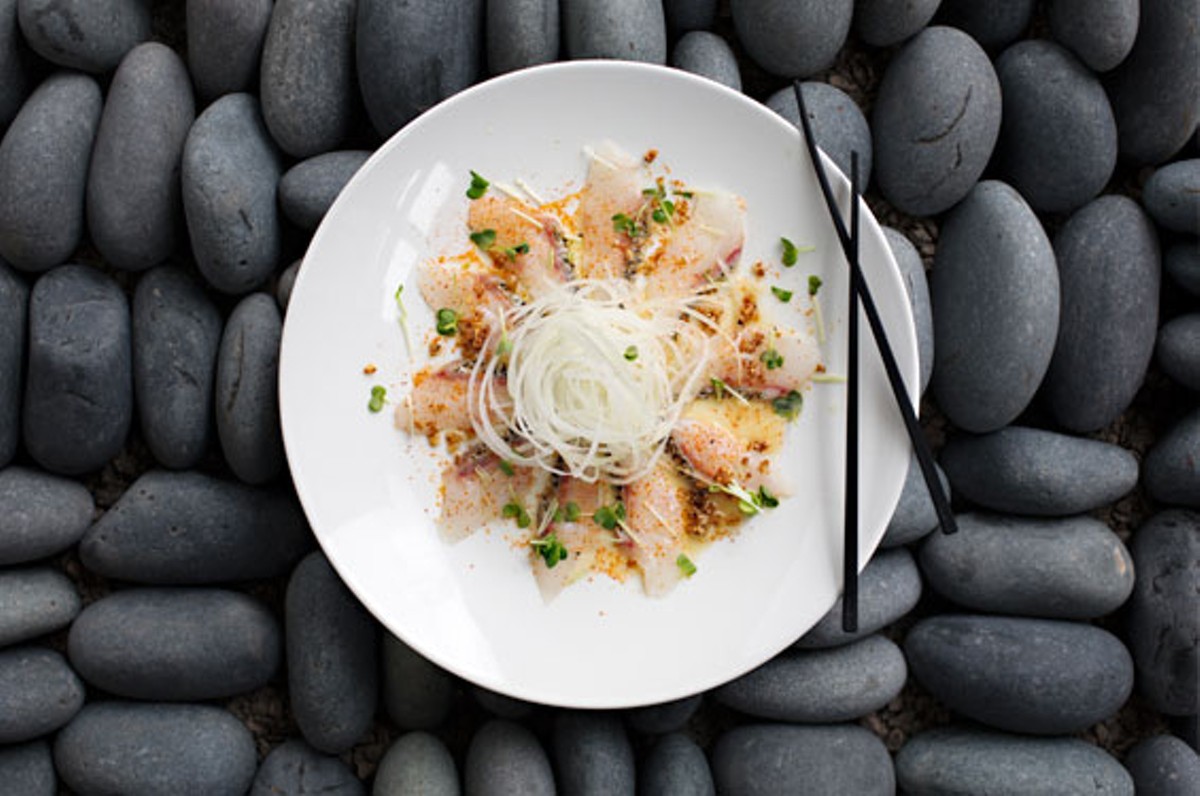The calamari looked innocuous enough when our server brought the appetizer: familiarly curled squid rings breaded and fried to a light golden brown, with aioli for dipping. My wife ate a few. I ate a few. We looked at each other.
"Where's the squid?" she asked.
"I don't know," I said and took a close look at one of the rings. It looked like fried calamari, but beneath the fried breading, there seemed to be nothing but...more fried breading. "I don't even know how this is scientifically possible."
"It's like it's there. But it's not."
Schrödinger's calamari.
I scraped as much breading as I could from another piece of squid. There was something underneath, after all: a spindly, off-white ring of squid, utterly desiccated. I snapped it in half with my fingers. It went crunch. I summoned our server. She examined the evidence. She made a face. The face looked like this: o_0. She said she'd tell the kitchen about the calamari. In the meantime, did we want a replacement order?
We did not.
The spirit of scientific inquiry notwithstanding, it is with some regret that I report that the calamari was the second-worst dish we had at dinner that evening at Takaya New Asian.
Takaya New Asian opened in January as part of the new Mercantile Exchange development downtown. Owners Eric and Jenny Heckman also operate Tani Sushi Bistro in Clayton, a restaurant I liked when I reviewed it in 2008 and to which I've returned several times since, and happily. Yet Takaya is such a spectacular failure that, as Pitchfork once memorably claimed about a new Weezer album, you have to consider whether the older work is as good as you remember.
The problems are apparent as soon as you walk in the door. The blissed-out faux-Portishead lounge music like the soundtrack to a soft-core flick on Cinemax. The open fireplace in the center of the dining room. The cushy booths big enough to hold an entire bachelorette party and the bride-to-be's inflatable replica of Jon Hamm's penis.
Slideshow: Inside Takaya New Asian
Is it 1997? No. Did the hostess, having run out of menus on one of our visits, ask us to share a single copy? She did. Does the menu feature Asian-fusion cuisine? You bet your bulgogi sliders it does.
Those sliders, selected from among the menu's list of appetizers and small plates, were one of the more successful dishes I encountered at Takaya. An order brings three (two, at lunch) miniature sandwiches with marinated steak on brioche buns. The meat was tender and flavorful, gently sweet, though the bread could have been fresher. Another appetizer, Korean-style grilled short ribs, featured a similar marinade — sugar and soy sauce, with hints of garlic — but tougher meat.
Grilled hamachi jaw is a "signature" appetizer. (The menu uses the term frequently — and spells it correctly, unlike "makerel" and "massago.") I thought it logical to try a signature appetizer. Our server took my order. She returned a few minutes later: the kitchen didn't have any grilled hamachi jaw that evening.
Another "signature" appetizer is mozzarella tempura — a fancy term for fried cheese sticks. These are crunchy and gooey but maybe not as salty as you want from fried cheese and, oh, God, I'm critiquing cheese sticks at an upscale downtown restaurant.
There's a sushi selection, which features nigiri sushi, sashimi and the over-the-top Americanized rolls for which Tani is known, such as the "Oh My God" roll, which arrives at your table completely engulfed in flames. At Tani the delicate knifework and no-nonsense presentation of the nigiri sushi impressed me. Here, ragged slabs of fish sat atop rice swabbed with too much wasabi paste. A piece of "makerel" was weirdly juicy, as if plucked from a bin of brine.
Dinner entrées include "specialty" sushi presentations, as well as more conventional — and certainly not "New Asian," however you choose to define that nebulous phrase — dishes, such as teriyaki (your choice of chicken or beef). Among the sushi entrées is "hamachi carpaccio." This, the menu boasts, isn't merely another "signature" dish, but Takaya's absolutely most outstanding, must-try dish. I thought it logical to try an absolutely most outstanding, must-try dish. Our server took my order. She returned a few minutes later: the kitchen didn't have any "hamachi carpaccio" that evening.
In its place our server directed me to a similar preparation with very thin slices of raw tuna and equally thin slices of avocado fanned around a plate. The tuna and avocado sat in an iridescent puddle of various sauces — soy, ponzu, something vaguely chile-mayonnaise-esque (it was difficult to tell) — that looked like an oil slick and tasted like tuna water.
The worst thing we ate on the night of Schrödinger's calamari was pan-seared sea bass in a garlic-miso sauce. A large hunk of fish sat atop a mound of rice, with a few paltry asparagus stalks doing garnish duty. The fish was inexplicably, mouth-hauntingly bitter — until I turned it over to reveal a crust of diced garlic that had been burnt black.
At least I found an explanation for the sea bass. I still can't figure out the squid. Admittedly, that's not entirely Takaya's fault. On a recent episode of the public-radio Zeitgeist prodder This American Life, a reporter obsessively bird-dogged a rumor that (once, maybe) a pork processor somewhere had packaged pig rectums (or, as they're called in the industry, "bung") as "imitation calamari." When the investigation proved fruitless, the reporter resorted to a blind taste test in which he pitted fried calamari against fried bung. One of the two participants preferred the bung.
I was not one of the tasters, and I'm pretty damn sure I've never eaten pig-butt rings à la calamari, but I suspect that in a blind tasting I'd have chosen 'em over the deep-fried squid I ate at Takaya.
I should mention that our server did delete the calamari from the bill. That kind gesture, however, barely dented the total tab: $90, for a dinner for two. Unless you're content with a minimalist selection of nigiri, a meal at Takaya will cost you. Maybe there was a time in St. Louis when merely opening a sleek new restaurant aping a played-out culinary trend was enough to serve as one of the cornerstones of splashy new downtown development.
In 2013, though, it comes off as a load of horse — well, you know. Rhymes with bung.
Slideshow: Inside Takaya New Asian






